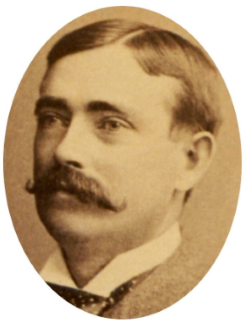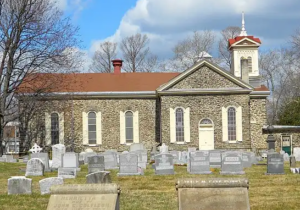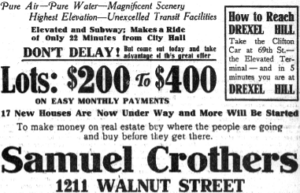Title: state representative, city councilman, real estate developer
Birthdate: October 12, 1856
Death Date: May 22, 1935
Plot Location: Section 141, Lot 21

There were seven siblings in Sam’s family that were older than him, plus two younger ones. Their parents were immigrants who settled in Philadelphia from northern Ireland. From a family of humble means, Sam amassed a fortune by selling new homes in suburban Drexel Hill. However, his first business was writing in stone, creating memorials for the deceased, many of which were placed right here at Mount Moriah.
He first appeared in the city directory in 1879, listing his business address as Mount Moriah Lane. His home address was 67th and Kingsessing Avenue, just three blocks from the cemetery’s entrance. He certainly got to know Horatio Connell, the superintendent, on more than just a business level. He learned a lot from the Connells about politics.
Horatio was elected to his first two-year term in the state House of Representatives in 1882. He was re-elected three times. Meanwhile, Sam won a seat on Philadelphia’s Common Council in 1886, where the term was for one year. (The city’s legislature had two houses, the other being the Select Council with a term of two years.) Learning from that experience led him to later run for the state House. He picked up the seat vacated by Horatio in 1890 and, like Horatio, was also re-elected three times.
 Another connection they had was at church. Two blocks south of the cemetery on Woodland Avenue between 68th and 69th Streets is St. James of Kingsessing (Episcopal) Church, where the Connells were lifelong members. It was there that Sam married Marion Kenney in 1887, and where all six of their children were baptized.
Another connection they had was at church. Two blocks south of the cemetery on Woodland Avenue between 68th and 69th Streets is St. James of Kingsessing (Episcopal) Church, where the Connells were lifelong members. It was there that Sam married Marion Kenney in 1887, and where all six of their children were baptized.
In 1884 Sam’s brother, William, decided to join him as a stonecutter. The job was such a good fit that the company became “Samuel Crothers & Bro.” in 1887. By 1889 Sam sold him the business and went into real estate. Being self-employed made splitting his time easier between home and Harrisburg while the Legislature was in session.
Sam left his seat in the House in 1898 and won the chance to represent his district in the Select Council. His counterpart in the Common Council was none other than Horatio’s son, Charles Connell. He not only served in City Hall as a councilman from 1893-1912, he worked 37 years as a city real estate assessor, from 1897 until he died in 1934. Sam no doubt gleaned some wisdom about real estate from him, but the two were also friends on a social level. Once in 1904 a newspaper story recounted a hunting trip they took to Virginia at the invitation of a school board member.
 Comments like this often found their way into the newspapers, because politics was a complicated and sometimes devious game. The business of government often took a back seat to haggling within the Republican-dominated councils. In 1906 Sam joined a reform movement called the City Party, breaking away from the party “machine.” He rode that wave of reform and was elected president of the Select Council. It only lasted a year, after charges were made about his profiting from his position. The leaders of both councils were voted out, with Sam declining to run again for office.
Comments like this often found their way into the newspapers, because politics was a complicated and sometimes devious game. The business of government often took a back seat to haggling within the Republican-dominated councils. In 1906 Sam joined a reform movement called the City Party, breaking away from the party “machine.” He rode that wave of reform and was elected president of the Select Council. It only lasted a year, after charges were made about his profiting from his position. The leaders of both councils were voted out, with Sam declining to run again for office.
 Meanwhile, a big real estate venture was paying off handsomely. He bought a farm in Drexel Hill, Delaware County and heavily advertised 815 lots for sale. He tried to call it “Drexel Heights,” but the name didn’t stick. Each house was to have partial stone exteriors that now characterize Drexel Hill across from Garrettford School. The features below speak for themselves, but the most telling comment is the sentence above his name, which could be the motto of every smart developer.
Meanwhile, a big real estate venture was paying off handsomely. He bought a farm in Drexel Hill, Delaware County and heavily advertised 815 lots for sale. He tried to call it “Drexel Heights,” but the name didn’t stick. Each house was to have partial stone exteriors that now characterize Drexel Hill across from Garrettford School. The features below speak for themselves, but the most telling comment is the sentence above his name, which could be the motto of every smart developer.

Both Sam and William dropped their membership in the 40th Ward Republican Club by 1907. Although no longer holding office, Sam continued to promote reform in the party by starting the William Penn Party, of which he was chairman. By 1912 he was chairman of the Washington Party which supported the return of Theodore Roosevelt as a presidential contender.
“Teddy” Roosevelt was president from 1901-1909, followed by William Howard Taft. T.R. soured on Taft so he tried to win the party’s nomination in 1912. Sam was part of a coalition backing his appearance in April at the Metropolitan Opera House on North Broad Street. He was one of the warm-up speakers before the candidate arrived, and sat on stage as he spoke to an overflow crowd. After failing to win at the convention that summer, T.R. launched a third-party bid. Sam supported the Progressive or “Bull Moose” Party although they lost in November.
Brother William passed away, having many children, and he passed on the monument business to his son, whose name was Samuel Robert Crothers. He continued in that career the rest of his life. Sam also had a son, Samuel Jr, and he carried on his father’s tradition of selling real estate.
“To make money on real estate, buy where the people are going, and buy before they get there.” He followed this advice again in 1918 when he bought a 30-acre estate just west of Swarthmore College. This time, it was home for him and his wife and the not-yet-married children. As time passed he carved out some of it to build more homes, bigger homes, at much higher prices.
He sold real estate in other places, of course, when it fancied him. Earlier in his career he was president of the Kingsessing & Tinicum Meadow Company, where he may have lost money due to the low elevation. There was a small development called Wissahickon Summit. Then in 1921 he built a block of row homes on 63rd Street south of Elmwood Avenue which sold quickly.
The not-yet-retired couple also took more time for leisure. They summered at Buck Hill Falls, a private resort community in the Pocono Mountains of northeastern Pennsylvania ,when they weren’t visiting their “cottage” in Atlantic City.
Sam parceled off some of his 30 acres to his children, three of whom lived there for many years afterward with their own cooks and butlers, a lifestyle their grandparents could have only imagined. One daughter married an attorney, one married an investment banker, a third married the owner of a printing company, and the other son was an architect.
 In 1935 Sam was standing at the 30th Street railroad station when he fell off the platform between two cars. He died four days later at age 78 from pneumonia ensuing from his injuries. Marion did not join him here until 33 years later, when she was 97 years old. This “ledger” grave was probably chosen in case some of their children wanted to have their inscriptions added. None did, except one who had died when he was just one month old in 1893.
In 1935 Sam was standing at the 30th Street railroad station when he fell off the platform between two cars. He died four days later at age 78 from pneumonia ensuing from his injuries. Marion did not join him here until 33 years later, when she was 97 years old. This “ledger” grave was probably chosen in case some of their children wanted to have their inscriptions added. None did, except one who had died when he was just one month old in 1893.
There are, however, plenty of Crothers here, in various locations, including Sam’s parents, five of his siblings and their children. One other burial was his aunt, Mary Ann Crothers, who is notable for having lived 104 years without ever being married.

Support the Friends of Mount Moriah
Help us in our mission to restore and maintain the beautiful Mount Moriah Cemetery by donating to our cause or volunteering at one of our clean-up events.

